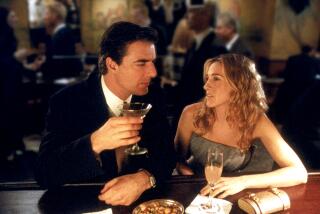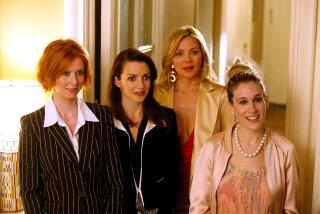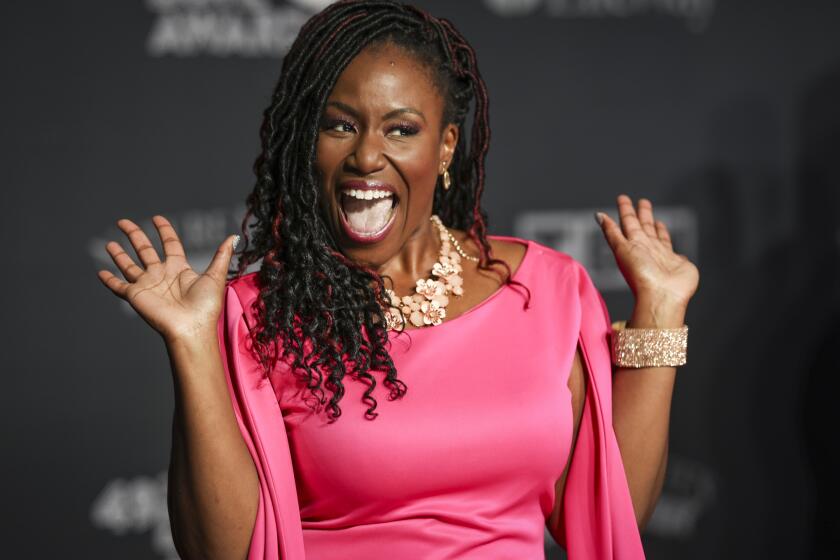Yes, ‘Sex and the City’ was unrealistic and too white. But it leveled the playing field in a man-dominated world
When “Sex and the City” arrived on HBO in June 1998, sopranos were still singers with high voices, Larry David was the guy who wrote “Seinfeld,” and “Six Feet Under,” “Deadwood” and “The Wire” were years away from being credited with starting a revolution of original cable series programming.
Carrie Bradshaw (Sarah Jessica Parker), Samantha Jones (Kim Cattrall), Charlotte York (Kristin Davis) and Miranda Hobbes (Cynthia Nixon) ushered in change on $900 Jimmy Choo stilettos, loosening up TV conventions as they swilled martinis in designer dresses some of them shouldn’t have been able to afford on their respective salaries.
Free of the constraints of network television, they cursed like R-rated film heroes, discussed sex in graphic detail, had lots of graphic sex and strived to be fabulous rather than likable.
“It’s slim pickings out there,” said Samantha during one of many episodes where the women were lamenting their dating prospects. “You can’t swing a Fendi purse without knocking over five losers.”
It was the cynicism of Gen X, coupled with a sexual awakening post-AIDS crisis, in an era when the city was moving up from grungy to moneyed. “Sex and the City” became must-watch Sunday night viewing for young(ish) women, gay men and anyone else who finally saw their deepest-buried drunken confessionals with friends and most disastrous/scandalous dating moments dramatized in the show.
“Sex and the City,” which ran for six seasons and spawned two feature films, was based on an anthology of work by New York Observer sex columnist Candace Bushnell. While the show could have easily alienated audiences accustomed to the tame Manhattanites of “Friends” who gathered at Central Perk around monster-sized coffee mugs, “Sex and the City” walked the line between fantasy, reality, sentimentality and raunch, sprinkling fashion-conscious fairy dust atop the raw truths of modern dating, gender disparity and ageism.
In Carrie’s world, walking 10 blocks in 6-inch heels was a glamorous act of independence, not a painful, crippling slog that ended in Duane Reade’s bandages and plastic flip-flop aisle. And all those high-end dinners and high-calorie drinks never resulted in Miranda bursting the seams of that tiny Patricia Field mini-dress.
I remember watching the premiere of “Sex and the City” in New York, where I lived at the time, prepared to hate the show for making their female characters so materialistic and man crazy.
Yet I loved it. Bad behavior, objectifying the other sex – we didn’t even know the real name of Carrie’s great love Mr. Big (Chris Noth) until the final episode – and seeking power in the workplace were equal-opportunity ventures in their version of Manhattan.
The weather was always temperate, and eligible men were so plentiful they appeared to drop out of the sky, unlike the sleet and rain that made my daily NYC experience too messy for open-toed shoes. But the show wasn’t meant to represent the real lives of city women. It was there to entertain those who hadn’t been represented.
“Sex and the City” has since been maligned for being unrealistic, for being too white and for setting feminism back with vain characters obsessed with shopping and sex.
But Carrie and company weren’t meant to carry the feminist mantle from “Murphy Brown” to “Girls,” HBO’s millennial version of “Sex and the City.” They simply leveled the playing field. They were the primary focus, and male characters were peripheral. It was their conversations we finally got to hear, not men talking about them.
Successful TV series with female-driven narratives were rare back then, and those that did survive past one season were often centered around motherhood or marriage. Buffy had only been slaying a little over a year, and “The Powerpuff Girls” were busy empowering, well, girls, not women.
The “Sex and the City” foursome, characters who vowed to remain true to one another no matter where their charmed lives took them, were equalizers. They weren’t acting like men, they were reflecting the changing values and roles of women from one generation to the next, which in Miranda’s case meant choosing to have a baby out of wedlock and in Samantha’s, sleeping with as many young men as possible.
Was the cast super white in a city that was not? Absolutely. Did the show miss about a billion opportunities to portray single, working women as more than the composite characters they sometimes were in “Sex and the City”? Yes. Perhaps if it was rebooted for the #MeToo era, it would tackle issues of representation, harassment in the workplace, or even the workplace. I never remember seeing any of them at work, except when Carrie was writing her column at home, in her way-too-nice-for-casual-lounging underwear.
Without the show, however, we may not be having the conversations today that have inspired more female-led narratives by female writers, like “Big Little Lies” or “The Handmaid’s Tale.” And it’s possible there wouldn’t be countless pieces like this one pondering the lack of diversity in a show that aired 20 years ago. And HBO might still be the home box office you watched only when you were too tired to change the channel.
“Sex and the City,” along with the uber-masculine 1997 prison drama “Oz,” was the first original series drama to make HBO a destination for smart, risky original series programming that bent rules and the ratings game. Otherwise, it’s doubtful those “Real Sex,” docu-porn, whatever-they-were shows and all those tired action film reruns (Steven Seagal, anyone?) would have bumped the network to the next level.
The series, which predated Tinder, streaming, Facebook and smartphones, has influenced the modern TV viewing experience far more than Carrie, Samantha, Miranda or Charlotte could have ever imagined when they were still making booty calls from pay phones. So don’t diminish the influence these women from a less politicized TV era still have on the shows we watch. They broke down barriers, even if it was with the swing of an absurdly priced Fendi handbag.
Have a ‘Sex and the City’-level breakup story? We want to hear it! »
More to Read
The complete guide to home viewing
Get Screen Gab for everything about the TV shows and streaming movies everyone’s talking about.
You may occasionally receive promotional content from the Los Angeles Times.







